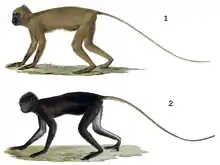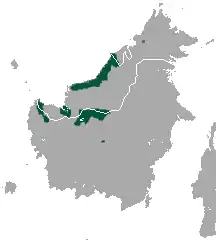| Sarawak surili[1] | |
|---|---|
 | |
| 1 - female, 2 - male. | |
| Scientific classification | |
| Domain: | Eukaryota |
| Kingdom: | Animalia |
| Phylum: | Chordata |
| Class: | Mammalia |
| Order: | Primates |
| Suborder: | Haplorhini |
| Infraorder: | Simiiformes |
| Family: | Cercopithecidae |
| Genus: | Presbytis |
| Species: | P. chrysomelas |
| Binomial name | |
| Presbytis chrysomelas (S. Müller, 1838) | |
 | |
| Sarawak surili range | |
The Sarawak surili,[1] Bornean banded langur,[2] or cross-marked langur[3] (Presbytis chrysomelas) is a species of primate in the family Cercopithecidae. It is endemic to the southeast Asian island of Borneo,[1][2] where it is distributed north of the Kapuas River in Kalimantan, Indonesia, the Malaysia states of Sarawak and Sabah, and in Brunei. Its taxonomy is complex and disputed,[4] and it has been considered a subspecies of P. femoralis or P. melalophos.[1] The Sarawak surili was formerly considered common, but has declined drastically due to persecution and habitat loss, and as of 2015 is only known from five sites with a combined population of 200–500 individuals.[2] Consequently, it is believed to be one of the rarest primates in the world, and has been rated as critically endangered by IUCN.[2]
References
- 1 2 3 4 Groves, C. P. (2005). Wilson, D. E.; Reeder, D. M. (eds.). Mammal Species of the World: A Taxonomic and Geographic Reference (3rd ed.). Baltimore: Johns Hopkins University Press. p. 170. ISBN 0-801-88221-4. OCLC 62265494.
- 1 2 3 4 5 Nijman, V.; Cheyne, S.; Traeholt, C.; Setiawan, A. (2020). "Presbytis chrysomelas". IUCN Red List of Threatened Species. 2020: e.T39803A17955321. doi:10.2305/IUCN.UK.2020-2.RLTS.T39803A17955321.en.
- ↑ "Presbytis chrysomelas (Müller, 1838)". Global Biodiversity Information Facility. Retrieved 22 August 2023.
- ↑ Brandon-Jones, D.; Eudey, A. A.; Geissmann, T.; Groves, C. P.; Melnick, D. J.; Morales, J. C.; Shekelle, M.; Stewart, C.-B. (2004). "Asian primate classification". International Journal of Primatology. 25 (1): 97–164. doi:10.1023/B:IJOP.0000014647.18720.32.
